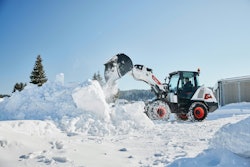Unlike most earthmoving equipment, asphalt pavers wrestle with a highly abrasive material. And they don’t just move asphalt mixtures – they push, shove, heat, flatten and smooth it using a long chain of interdependent subsystems. One break in the chain and you’ve got a non-functional paver and truckloads of hot asphalt with nowhere to go.
As a result, all the material conveyance subsystems – the chains and flights, the auger and its bearings, the screed plate and floor plate – are examined and evaluated thoroughly at the end of every season. Some of these components are replaced, refaced or rebuilt every season, and most are made new again within two to three seasons.
These regular rebuilds are part of the lifecycle costs of owning and operating a paver. But with good maintenance, it’s not uncommon for contractors today to squeeze seven to nine years out of their asphalt paving machines before selling them or assigning them to secondary roles.
Technology keeping up with demands
The demands placed on asphalt pavers have been steadily increasing over the past decade. In response manufacturers have created more durable wear parts and systems, but overall the hourly lifecycles of these subsystems are staying about the same as contractors push the outer limits on hours and tonnages.
Today’s asphalt paver will see a minimum of 750 to 1,000 hours and an average of around 1,200 hours per year. But the length of the paving season is largely determined by what part of the country it is in. In Pennsylvania your paving season may run from April 15 to November 1. That same paver in Phoenix is going to run at least 11 months out of the year.
Different regions also use different stone in the asphalt mix. Georgia and some New England states use very abrasive granite while Midwestern contractors use softer limestone. In most cases, asphalt mixes use local aggregates. These materials vary in hardness and abrasiveness across the country. The variation in material properties leads to different wear rates on laydown equipment.
Along with longer hours come increased tonnages. Larger pavers typically see 3,000 tons a day, but Steve Neal, product manager, Blaw-Knox, says there are contractors pushing to get as much as 6,000 tons a day, if the job specifications have the potential to allow that kind of production.
First and second economic life
While it is possible to regularly rebuild asphalt paver wear parts and keep these machines going for 10 or even 15 years, most contractors are going to sell or trade their machines before then. “Most people keep our pavers five, six or seven years and then trade,” says Mark Bolick, service manager LeeBoy. “That’s the asphalt contractor’s bread-and-butter machine. You don’t want 10 trucks out there at $500 a load and have your paver break down, so they depreciate them over three to five years and then replace them.”
“Years ago, the range was more like 10 to 15 years,” Neal says. “Now its seven to nine, maximum.” Within that seven-to nine-year period the machine will likely go through two major overhauls (engine and transmission excluded).
Contractors start looking at their first major rebuild at around 3,000 to 4,000 hours of use, according to a Roadtec spokesperson. This would include the slat conveyor floor, the flight slats and chains, sprockets, augers, bearings, screed plates and a thorough hydraulic checkup.
The second rebuild is more extensive. “You just about have to go through everything and look at all of the hydraulic systems,” Neal says. “If you didn’t have any hydraulic repairs on the first overhaul, you probably will on the second. You also have to check the auger conveyor system, not only the wear items but also the drive box. “You’re looking at a total tear down – build it up, reshim it, rebush it, reweld it, whatever it needs – so you’re really into the dollars.”
The cost and value of a major rebuild
A total rebuild of this magnitude may cost as little as 20 percent of the cost of a new machine, Neal says. The most expensive rebuild Neal says he’s seen ran about 50 percent of the cost of new, but that was a case of severe neglect.
Properly rebuilt, however, used asphalt pavers, even after their second rebuild, can be put to limited or secondary use and continue to deliver value to the contractor. “The guy that buys a paver new is going to run 1,000 hours a year,” Bolick says. “The guy who buys used is going to run about 300 or 400 hours a year. He’ll probably run it as-is the first year and if he sees he’s going to use it enough, do a rebuild. Then he’ll fix parts as needed.”
Smaller screeds wearing faster
The screed plate is typically the first component to wear out on an asphalt paver. “In some areas where granite materials are used it may be necessary to change plates up to four times a year,” says Jerry Wright, business development manager, Vogele America. “Yet in other areas it is not unusual to use a screed through two or three seasons before it needs changing.”
The lifecycle of a screed plate is best measured by the tons of material used rather than the operating hours, says Wright. And the life of a screed plate can be reduced by 75 percent or more if it’s not adjusted properly. Pre-strike-off adjustment, height of extensions relative to the main screed and the angle of attack all determine how often you will replace your screed plates, he says.
Increases in daily volume and the increasing complexity of power-extendable screeds have also had an impact on screed plate life. “With the old bolt-together screed plates people expected to get two to three years out of them, but then tonnages went up and all of a sudden the life went down,” Neal says. “Then we went to power extendable screeds and the screed plates were made shorter, and that almost doubled your pounds per square inch.” Manufacturers responded with improved metallurgy resulting in screed plates that can usually get at least a full season of use and two or three seasons with more forgiving conditions.
Screed heaters are also a component to keep an eye on, both oil fired and electric. “It is imperative that burners be properly maintained and operated since this can greatly affect the life of screed plates,” Wright says. “Overheated screeds will warp and wear out much quicker. Material will cling to cold screeds and cause uneven wear and again reduce life.”
The cost of replacing screed plates varies by their size and the difficulty of the job. On the commercial-class pavers that LeeBoy specializes in, replacement screed plates will run more than $600, Bolick says. On highway-class machines (19,000 pounds and up) the plates may run $1,500 to $2,000, Neal says, and the labor may vary from one mechanic working two hours to two mechanics laboring the better part of a day.
The auger and bearings
Under average conditions an auger should last up to four seasons. As with screed plates, the abrasiveness of the mix and the number of tons run through the auger determine how long it will last. With cast auger segments, it’s important to visually inspect the segments for cracks on a routine basis so that one doesn’t break off and snag a streak in the asphalt behind it. Some auger segments are cast products, some are steel with wear plates welded onto the steel. The durability varies with the type of material used.
A lot of auger segments are damaged during the loading and off-loading of the machines when they’re banged and bounced on the trailer ramps. Another way operators can shorten the life of the auger is to overfeed it or overfill the hopper, says Larry Peyton, paving equipment service manager for Terex/Cedarapids.
Perhaps even more important than the auger itself is the bearing that the auger shaft rotates in. The bearings only cost a few dollars, but should one seize up, it instantly stops the machine. A shot of grease at the end of the day is usually enough to keep these bearings healthy, says Neal. And most contractors replace the bearings every year. Still, getting workers to cleanup and grease a machine after a 12-hour day can be difficult. Several manufacturers have gone to a sealed bearing that doesn’t require grease, but even these should only go two seasons before being replaced, Neal says. The other 10 or so bearings in the material conveyance system are equally as important, he adds.
But barring unintentional damage, the auger segments will wear out uniformly and be replaced as a complete set. Replacing an entire set runs about $4,000.
Chains and flights
It’s not unusual to get four or five years out of the chains and flights that move the asphalt back through the hopper. (The flights go by a variety of other names including paddles, bars and slats.) You want to check the chains for wear and stretch and keep proper tension on them to get the maximum life. The newer offset-link chains have half-link segments that you can remove to adjust out slack. Unlike the cast-link chain, you don’t reverse the offset-link chains at the halfway point in their lifecycle.
“We got almost three times the life on the chain by going to the offset link,” Neal says, “and we doubled the life of the sprocket. Cast link chains are still found on some machines, and Blaw-Knox puts them on its smaller pavers, Neal says. A pair of replacement chains, cast or offset, will run about $4,500 to $6,000.
Some manufacturers use a system with integral chains and flights that are replaced as a single unit. Others separate these two components so they can be replaced individually. “Typically the slat bars don’t wear as soon as the chains, so they can last past five years,” Peyton says. The chains alone may need replacement every three years or after a million tons, he says.
Chains can wear prematurely if your preventative maintenance isn’t good, Peyton cautions. “The slat runs in the mix, but the chain is protected under skirt boards,” he says. “If you let them wear to a point where mix gets underneath them and you start running the chains in the mix, it will cut the life considerably. So you need to make sure that the skirt boards are in good repair and adjusted.” Chain replacement will run from $4,000 to $6,000. Flight or bar replacements will cost anywhere from $2,500 to $4,000.
Tracks vs. wheels
Of the two types of asphalt paving machines, wheeled and tracked, wheeled pavers are the least expensive machines to buy and maintain, Wright says. Maintenance on wheels is simple – maintain proper inflation with ballast and air. “It’s imperative that the volume of ballast in the tires is exactly the same in each tire and the air pressure be exactly the same in each tire,” Wright says. Should the ballast vary, the tire with the least ballast will constantly spin out causing it to wear prematurely. Likewise the tire with too much air will spin out causing premature wear.
In the past, Neal says, wheeled machines outsold steel-track machines by a margin of two to one or three to one. But with the introduction of rubber tracks, sometimes called high-speed tracks, the numbers are changing. “The high-speed tracks give you speed and better ride-ability,” Neal says. And the market share for high-speed rubber tracks compared to wheeled pavers is growing. “It’s not one to one, yet,” Neal says, “but a lot of people think there will be parity.”
Rubber-track pavers normally cost more to buy than comparable steel track versions, but most manufacturers anticipate the owning and operating costs of a rubber-track paver will be lower than that of the steel-track machine over the complete lifecycle. Rubber-tracked pavers have only been around a few years, so there is not yet enough information to pinpoint their complete lifecycle costs. But they are popular. The manufacturers of highway-class asphalt pavers interviewed for this article – Blaw-Knox, Cedarapids, Vogele and Roadtec – report that rubber-track machines are outselling steel-track machines by eight or nine to one.
Bolick says LeeBoy is aware of the high-speed rubber tracks, however, “At LeeBoy nine out of 10 commercial-class pavers sold leave the factory with steel tracks,” he says. The steel rail lasts several seasons or 2,000 hours, Bolick says. Replacement of the rails and rollers will run you from $4,000 to $7,000 and can usually be done in a day.
Protecting undercarriage assets
“The major factor affecting the life of the undercarriage, whether steel or rubber, is alignment. They must be kept in alignment in order to enjoy maximum life,” Wright says. “Also, if the operator keeps the track clean, again whether they are steel or rubber, this will determine how long a track will last.” Wright also recommends operators trailer a paver rather than crawl it to avoid unnecessary wear when moving over distances or around the jobsite.
Best-guess estimates of the component life for rubber tracks and undercarriages on highway-class pavers is four to five seasons. Replacement costs, as with any track-driven system, are substantial, in the $18,000 to $20,000 range.
Major systems: engine, transmission
Properly maintained, the engine on an asphalt paver can last 10 years or 10,000 hours or more before a rebuild is in order. “Most of the time we are only using 40 to 60 percent of the horsepower,” Neal says. “So longevity is a matter of how well they do their maintenance. I’ve seen a lot of 10- and 15-year-old machines out there and their engines have never been touched.”
Operator skill can also affect engine life, Wright notes. “If the operator shuts the engine down when operating at full rpm, he will shorten the life dramatically. Engines used in cold climates are more likely to suffer damage from starting when using starting aids such as ether,” he says. The type of hauling units can also have an effect. “For example, in Michigan they use hauling units that have up to 50-ton payloads, which make the engine work much harder than normal,” Wright says.
Final drives will normally last for five or more years, and the same items that reduce the life of the engine will also affect the final drive system. “The first component needing attention will most likely be the hydrostatic transmission,” Wright says. “This includes the pump and motor since the pump will usually fail first and then cause the motor to fail since the filter is on the return side of the hydraulic circuit.” Hydraulic pumps and motors used for driving the auger conveyor systems have approximately the same lifecycles as the main traction pumps and motors.










